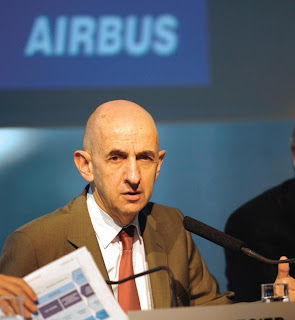Simply stated – high-flying vision which Airbus clearly lacks as Craig Fraser, Analyst, Fitch Ratings, expressed exclusively to B&E as, “The Boeing 787 has the more favourable market outlook as the market for an aircraft the size of the 787 is larger than the market for a jumbo like A380! Currently, we rate EADS’s credit quality (Airbus’ parent) ‘A-’ with a negative outlook while Boeing’s is currently rated ‘A+’ with a stable outlook...”
Boeing 787 has the more favourable market outlook as the market for an aircraft the size of the 787 is larger than the market for a jumbo like A380! Currently, we rate EADS’s credit quality (Airbus’ parent) ‘A-’ with a negative outlook while Boeing’s is currently rated ‘A+’ with a stable outlook...”
Boeing’s twin-aisle aircraft s also provide the right sizes to fill-up demand gaps in terms of seat capacities while Airbus, below its 555-seater A380, has just the A340 which offers a seating capacity of 323 seats – a gap of 232 seats! Is it any wonder then Teal Group Corp. estimates Boeing to capture 62% of the market by 2015? Boeing also scores higher on its risk-sharing model as its Risk Sharing Partners (RSPs) share almost 80% of all ‘new model development’ R&D risks. Louis Gallois, CEO, Airbus also confessed, “Our long term future is at stake if we don’t act now...’ So while ‘wiring problems’ rattled Airbus’ & gave smiles to the American, you could shout – “Crisis in EU?! Yes & short circuits too!”
323 seats – a gap of 232 seats! Is it any wonder then Teal Group Corp. estimates Boeing to capture 62% of the market by 2015? Boeing also scores higher on its risk-sharing model as its Risk Sharing Partners (RSPs) share almost 80% of all ‘new model development’ R&D risks. Louis Gallois, CEO, Airbus also confessed, “Our long term future is at stake if we don’t act now...’ So while ‘wiring problems’ rattled Airbus’ & gave smiles to the American, you could shout – “Crisis in EU?! Yes & short circuits too!”
 Boeing 787 has the more favourable market outlook as the market for an aircraft the size of the 787 is larger than the market for a jumbo like A380! Currently, we rate EADS’s credit quality (Airbus’ parent) ‘A-’ with a negative outlook while Boeing’s is currently rated ‘A+’ with a stable outlook...”
Boeing 787 has the more favourable market outlook as the market for an aircraft the size of the 787 is larger than the market for a jumbo like A380! Currently, we rate EADS’s credit quality (Airbus’ parent) ‘A-’ with a negative outlook while Boeing’s is currently rated ‘A+’ with a stable outlook...”Boeing’s twin-aisle aircraft s also provide the right sizes to fill-up demand gaps in terms of seat capacities while Airbus, below its 555-seater A380, has just the A340 which offers a seating capacity of
 323 seats – a gap of 232 seats! Is it any wonder then Teal Group Corp. estimates Boeing to capture 62% of the market by 2015? Boeing also scores higher on its risk-sharing model as its Risk Sharing Partners (RSPs) share almost 80% of all ‘new model development’ R&D risks. Louis Gallois, CEO, Airbus also confessed, “Our long term future is at stake if we don’t act now...’ So while ‘wiring problems’ rattled Airbus’ & gave smiles to the American, you could shout – “Crisis in EU?! Yes & short circuits too!”
323 seats – a gap of 232 seats! Is it any wonder then Teal Group Corp. estimates Boeing to capture 62% of the market by 2015? Boeing also scores higher on its risk-sharing model as its Risk Sharing Partners (RSPs) share almost 80% of all ‘new model development’ R&D risks. Louis Gallois, CEO, Airbus also confessed, “Our long term future is at stake if we don’t act now...’ So while ‘wiring problems’ rattled Airbus’ & gave smiles to the American, you could shout – “Crisis in EU?! Yes & short circuits too!” For Complete IIPM Article, Click here
Source: IIPM Editorial, 2008
An IIPM and Management Guru Prof. Arindam Chaudhuri's Initiative
Source: IIPM Editorial, 2008
An IIPM and Management Guru Prof. Arindam Chaudhuri's Initiative
IIPM, Business College Ranking India BBA Institute India, IIPM IIPM - Nikhil Khade Online Welcome to 4Ps Business and Marketing The IIPM Think Tank IIPM New Delhi India Professor Arindam Chaudhuri, Renowned Management Guru & Economist IIPM Info Planning and Entrepreneurship Programme, IIPM New Delhi, India Business And Economy IIPM Placements New Delhi, India IIPM Business Management Institute India

